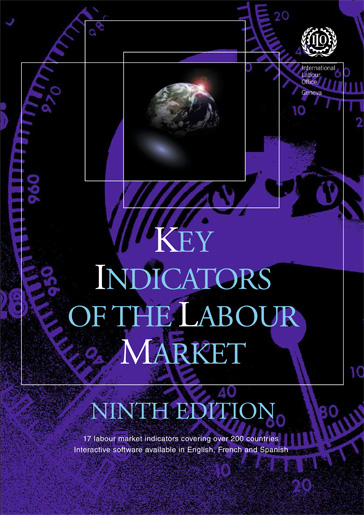Publications
2015
-
Key Indicators of the Labour Market 2015 (KILM): Preface
16 November 2015
The KILM is a multifunctional research tool designed to make labour market information and analysis easily accessible.
-
Key Indicators of the Labour Market 2015 (KILM): Acknowledgement
16 November 2015
The KILM is a multifunctional research tool designed to make labour market information and analysis easily accessible.
-
Key Indicators of the Labour Market 2015 (KILM): Executive Summary
16 November 2015
The KILM is a multifunctional research tool designed to make labour market information and analysis easily accessible.
-

17. Poverty, income distribution, employment by economic class and working poverty
16 November 2015
Tables 17a and 17b present two of the indicators that were used for monitoring progress toward the first UN Millennium Development Goal (MDG), “eradicating extreme poverty and hunger”, while the MDGs were in force.
-

16. Labour productivity
16 November 2015
This chapter presents information on labour productivity for the aggregate economy with labour productivity defined as output per unit of labour input (persons engaged or hours worked). Labour productivity measures the efficiency of a country with which inputs are used in an economy to produce goods and services and it offers a measure of economic growth, competitiveness, and living standards within a country.
-

15. Wages and compensation costs
16 November 2015
This chapter presents two distinct and complementary indicators. The first, table 15a, shows trends in average monthly wages in the total economy for 126 countries, while the second, table 15b, presents the trends and structure of employers’ average compensation costs for the employment of workers in the manufacturing sector, available for 33 countries.
-

14. Educational attainment and illiteracy
16 November 2015
KILM 14 reflects the levels and distribution of the knowledge and skills base of the labour force and the unemployed. Tables 14a and 14b show the distribution of the educational attainment of the labour force and the unemployed for 137 and 141 countries, respectively, according to five levels of schooling – less than one year, pre-primary level, primary level, secondary level, and tertiary level.
-

13. Persons outside the labour force
16 November 2015
The inactivity rate is the proportion of the working-age population that is not in the labour force. Summing up the inactivity rate and the labour force participation rate (see KILM 1) will yield 100 per cent. Information on this indicator is given for 189 economies for the same standardized age groupings provided in KILM table 1a: 15+, 15-24, 15-64, 25-54, 25-34, 35-54, 55-64 and 65+.
-

12. Time-related underemployment
16 November 2015
This indicator relates to the number of employed persons whose hours of work in the reference period are insufficient in relation to a more desirable employment situation in which the person is willing and available to engage. The indicator was previously known as “visible underemployment”.
-

11. Long-term unemployment
16 November 2015
The indicators on long-term unemployment look at duration of unemployment, that is, the length of time that an unemployed person has been without work, available for work and looking for a job. KILM 11 consists of two indicators, one containing long-term unemployment (referring to people who have been unemployed for one year or longer); and the other containing different durations of unemployment.